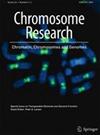Karyotype asymmetry in Cuscuta L. subgenus Pachystigma reflects its repeat DNA composition
IF 2.8
4区 生物学
Q3 BIOCHEMISTRY & MOLECULAR BIOLOGY
引用次数: 6
Abstract
Cuscuta is a cytogenetically diverse genus, with karyotypes varying 18-fold in chromosome number and 127-fold in genome size. Each of its four subgenera also presents particular chromosomal features, such as bimodal karyotypes in Pachystigma. We used low coverage sequencing of the Cuscuta nitida genome (subgenus Pachystigma), as well as chromosome banding and molecular cytogenetics of three subgenus representatives, to understand the origin of bimodal karyotypes. All three species, C. nitida, C. africana (2n = 28) and C. angulata (2n = 30), showed heterochromatic bands mainly in the largest chromosome pairs. Eighteen satellite DNAs were identified in C. nitida genome, two showing similarity to mobile elements. The most abundant were present at the largest pairs, as well as the highly abundant ribosomal DNAs. The most abundant Ty1/Copia and Ty3/Gypsy elements were also highly enriched in the largest pairs, except for the Ty3/Gypsy CRM, which also labelled the pericentromeric regions of the smallest chromosomes. This accumulation of repetitive DNA in the larger pairs indicates that these sequences are largely responsible for the formation of bimodal karyotypes in the subgenus Pachystigma. The repetitive DNA fraction is directly linked to karyotype evolution in Cuscuta.厚柱头菟丝子亚属核型不对称反映了其重复DNA组成
菟丝子属是一个细胞遗传学多样的属,其核型在染色体数量上变化了18倍,在基因组大小上变化了127倍。它的四个亚属中的每一个也都具有特定的染色体特征,例如Pachystigma的双峰核型。我们使用了菟丝子基因组(Pachystigma亚属)的低覆盖率测序,以及三个亚属代表的染色体显带和分子细胞遗传学,来了解双峰核型的起源。所有三个物种,C.nitida、C.africana(2n=28)和C.angulata(2n=30),主要在最大的染色体对中显示异色带。在C.nitida基因组中鉴定出18个卫星DNA,其中两个与移动元件相似。最丰富的存在于最大的对,以及高度丰富的核糖体DNA。最丰富的Ty1/Copia和Ty3/Gypsy元素在最大的配对中也高度富集,除了Ty3/Gyssy CRM,它也标记了最小染色体的着丝粒周围区域。这种重复DNA在较大配对中的积累表明,这些序列在很大程度上是Pachystigma亚属双峰核型形成的原因。菟丝子的重复DNA部分与核型进化直接相关。
本文章由计算机程序翻译,如有差异,请以英文原文为准。
求助全文
约1分钟内获得全文
求助全文
来源期刊

Chromosome Research
生物-生化与分子生物学
CiteScore
4.70
自引率
3.80%
发文量
31
审稿时长
1 months
期刊介绍:
Chromosome Research publishes manuscripts from work based on all organisms and encourages submissions in the following areas including, but not limited, to:
· Chromosomes and their linkage to diseases;
· Chromosome organization within the nucleus;
· Chromatin biology (transcription, non-coding RNA, etc);
· Chromosome structure, function and mechanics;
· Chromosome and DNA repair;
· Epigenetic chromosomal functions (centromeres, telomeres, replication, imprinting,
dosage compensation, sex determination, chromosome remodeling);
· Architectural/epigenomic organization of the genome;
· Functional annotation of the genome;
· Functional and comparative genomics in plants and animals;
· Karyology studies that help resolve difficult taxonomic problems or that provide
clues to fundamental mechanisms of genome and karyotype evolution in plants and animals;
· Mitosis and Meiosis;
· Cancer cytogenomics.
 求助内容:
求助内容: 应助结果提醒方式:
应助结果提醒方式:


